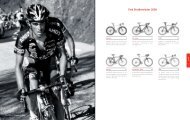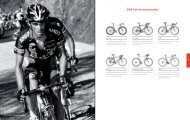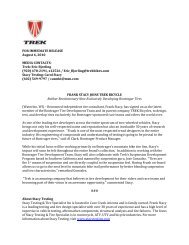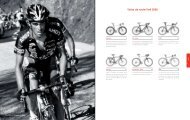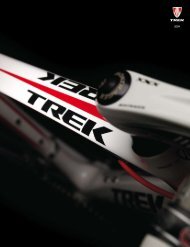Airfoil Development for the Trek Speed Concept ... - Slowtwitch.com
Airfoil Development for the Trek Speed Concept ... - Slowtwitch.com
Airfoil Development for the Trek Speed Concept ... - Slowtwitch.com
Create successful ePaper yourself
Turn your PDF publications into a flip-book with our unique Google optimized e-Paper software.
4 Yaw<br />
Yaw is angle between <strong>the</strong> total airspeed vector (apparent wind) and <strong>the</strong> direction of bicycle motion. In cycling, some amount of yaw<br />
almost always exists, since <strong>the</strong> wind speed is very rarely zero, and <strong>the</strong> cycling direction very rarely aligns perfectly with <strong>the</strong> wind<br />
direction. As is shown in <strong>the</strong> following figure, <strong>the</strong> yaw angle is determined by <strong>the</strong> cyclist’s speed, wind speed, and wind direction.<br />
Figure 22: Vector diagram of <strong>the</strong> yaw angle.<br />
Bicycles see much higher yaw angles than practically any o<strong>the</strong>r aerodynamic device because <strong>the</strong>y travel at speeds similar to <strong>com</strong>mon<br />
wind speeds. For example, <strong>for</strong> a cyclist riding at 20 mph, it takes a side wind of only 5.4 mph to generate a yaw angle of 15°. The<br />
yaw angles <strong>for</strong> a range of <strong>com</strong>mon side wind conditions are tabulated <strong>the</strong> figure below. A cyclist can use this figure to look up his/<br />
her riding speed (horizontal axis) and find <strong>the</strong> corresponding yaw angle (vertical axis) <strong>for</strong> a wide range of side wind speeds (multiple<br />
curves). Note that <strong>the</strong> average wind speeds along <strong>the</strong> Ironman World Championship course in Hawaii typically exceed 20 mph,<br />
particularly on <strong>the</strong> north side of <strong>the</strong> island [11]. As was seen in <strong>the</strong> wind tunnel data, <strong>the</strong> KVF and <strong>Speed</strong> <strong>Concept</strong> were designed to<br />
per<strong>for</strong>m particularly well at yaw.<br />
Figure 23: Yaw angles <strong>for</strong> a wide range<br />
of rider velocity (horizontal axis) and side<br />
wind speeds (curves).<br />
19









